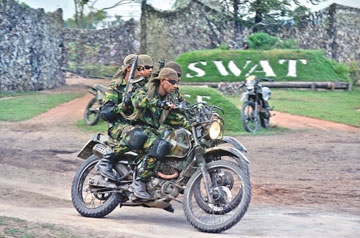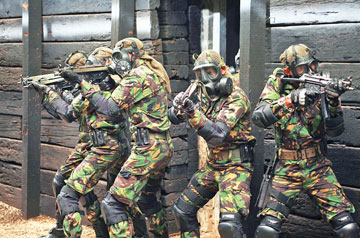SWAT elite force ready to undertake the impossible
By Kurulu Kariyakarawana
It was the noon of Friday, June 29, 2012. Over 250 inmates of the
Vavuniya Prison including a large number of political prisoners staged a
massive hunger strike protesting over the alleged assault and torture on
one of the inmates by the prison management. The rebelling inmates took
three guards into custody and shut down the entire premises making no
entry for any law enforcement force. Several hundred heads of local
police and the military backed by Army Commandos tried to penetrate the
tall and well-fortified prison walls but failed due to continuous
pelting of stones by the inmates. Out of sheer desperation the heads of
the police department depended on their last resort -the SWAT force was
brought into the scene.
 |
 |
| In training at
Katukurunda |
 |
During the prison turmoil, what SWAT did was seemingly impossible for
another armed force to imagine. Several eight man units started firing
number of tear gas canisters into the prison before breaking into the
premises through blocked entrances and climbing over the walls. Well
equipped with guns and gas masks SWAT crashed into the prison compound,
which was already covered in a dense cloud of tear gas crippling the
violent inmates who continued to pelt stones and solid objects at the
penetrating forces. It took a few moments for these specialised men to
get a hold of the situation and rescue the three prison guards unscathed
from a dangerous hostage drama in history.
As you may have seen in Hollywood style blockbuster action films,
where a contingent of heavily armoured armed men crash into panic
stricken scenes of exchanging fire in a Black armoured van displaying
the letters S.W.A.T. The acronym stands for Special Weapons And Tactics,
a specially trained elite force armed with the most modern weapons to
meet any type of contingency. It is a commonly used name for law
enforcement units, which use military-style light weapons and
specialised tactics in high-risk operations that fall outside the
capabilities of the regular, uniformed police force. "SWAT" is commonly
used internationally, as a colloquial generic term for these units.
Their duties include confronting heavily armed criminals, performing
hostage rescue and counter-terrorism operations, high risk arrests and
entering armoured or barricaded buildings. Such units are often equipped
with specialised firearms including submachine guns, assault rifles,
breaching shotguns, sniper rifles, riot control agents and stun
grenades. They have specialised equipment including heavy body armour,
ballistic shields, entry tools, armoured vehicles, advanced night vision
optics and motion detectors for covertly determining the positions of
hostages or hostage takers inside enclosed structures.
Well like the USA or any other super power Sri Lanka now has its own
SWAT team under the paramilitary wing of the Police Department, the
Special Task Force. The necessity to form SWAT in Sri Lanka was mainly
felt following the Mumbai terror attacks in November, 2008 that killed
164 and wounded over 300 within four days.
Since a militarily powerful country like India was not ready to face
such an unexpected blow concerning local terrorist activities, which was
at its peak, the need to establish a specialised unit to fight in close
quarter combats was lengthily discussed by top security officials.
Also to handle VVIP security from the local terrorist outfit and to
face any high threat situation, SWAT was set up on November 30, 2008,
just a day after the four-day gruesome Mumbai attack was brought under
control. By that time the state intelligence services had received
credible information leading to pre-planned attacks on key economic
centres in the city as well as airports and sea ports to detach the
country from foreign aid and assistance. Action had to be taken and it
had to be fast.
The then Inspector General of Police, Jayantha Wickramaratne ordered
Senior Deputy Inspector General Mahinda Balasuriya to work out a system
to form a specialised unit. SDIG Balasuriya ordered the STF to look into
the matter as it was the elite force of the Police. Then STF Commandant
DIG Sarathchandra Ranawana took the initiative to form the new unit with
a handful of skilled officers in his wing. ASP Lakshman Abeykoon, Chief
Inspectors R M Wimalaratne and Sanjaya Attigala who had had an initial
specialised training at the Los Angeles SWAT in early nineties commenced
the unit.
The trainees for the new unit were absorbed from the regular STF
cadre. Those who have completed the basic STF course was subjected to an
intense physical training from which the trainees for SWAT were
selected. The selection was done on a merit base that depended on the
personal endurance and stamina of the trainees. The selected personnel
were given a special training at the STF Training School in Katukurunda.
Initially a batch of 80 personnel completed the training and formed
SWAT.
ASP SWAT Lakshman Abeykoon told the Sunday Observer that the trainees
will have to master 13 different courses during a period of several
months.
They will be first given a training on the most important course of
all, the Close Quarter Battle and Hostage Rescue. This will teach them
how to face an enemy in an enclosed urban facility apart from the usual
jungle fighting. Personnel will be trained to fight an armed enemy in a
public environment without hurting a single civilian and to rescue a
hostage from a high risk situation without any harm being done to the
victim.
Next they will be given a comprehensive training on weapon handling
and firing. How to use special weapons which the normal armed forces
would not get to handle. Training on special automatic guns like MP5,
Uzi, Pistols like Nine MM, Browning, Glock and Shot Guns. In other words
they will get to handle the most latest weapons being handled by the
troops in USA and Israel. Samples of all these modern weapons have been
provided to the SWAT armoury to conduct their trainings and missions.
Basic Parachute course is a must where it will enable the troops to
enter into high elevated positions or buildings by air and carry out
rescue operations. Sri Lanka Air Force is conducting this course whilst
the SL Navy is giving them a water borne course to be familiarised with
great depths and rough waters. Abseiling, rappelling and slithering will
assist them to climb down any height with confidence and skilfully.
The rest of the training includes explosives handling and tracking,
unarmed fighting with mix martial arts skills, a first aid course,
high-tech equipment handling course and training on riot control. Riot
control has taken a prominent training these days to control mobs with
using minimum force. The SWAT also has a special motorcycle rider course
and VIP vehicle backup training to master driving skills in a special
environment.
The knowledge in intelligence service will enable them to act
discretely and find information about the enemy forces. One of the chief
responsibilities the SWAT has is to handle VIP security and backup.
Since 2008 the SWAT has been covering the security of all the foreign
political and other VIPs. When a state leader visits Sri Lanka, the VIP
will be provided with a 24 hour SWAT team.
The recent visit of Maldives President and its Police Commissioner as
well as the visiting Pakistan Cricket team were provided with SWAT
units. For the past few years SWAT has conducted a range of missions
including arrests of most wanted underworld drug kingpins like Faji and
Mamasmi, the recent major heroin detection in Kelaniya, riot control at
the recent Aluthgama clashes and Rathupaswala public unrest.
They will also be used to transport high profile LTTE suspects
detained at the Boossa Camp to various outstation courts of law.
OIC SWAT CI Sagara Kulasekara will take orders from ASP Abeykoon and
STF Commandant Ranjith Perera in dispatching units to any part of the
country depending on the gravity of the situation.
The unit remains under the direct supervision of IGP N K Illangakoon
who will decide when to summon this special force. Always trying to
master power, speed and accuracy, SWAT will remain as standby round the
clock to respond to any out-of-hand eventuality. In 2009, a Constable
attached to the service of the Police Hospital in Narahenpita took one
of his fellow Women Police Constables hostage at gunpoint.
The daring cop who demanded certain things opened fire at the
approaching police forces to retreat to safer locations. SWAT was
summoned to take the situation under control and rescue the victim,
which they did in due course without a mishap. |

